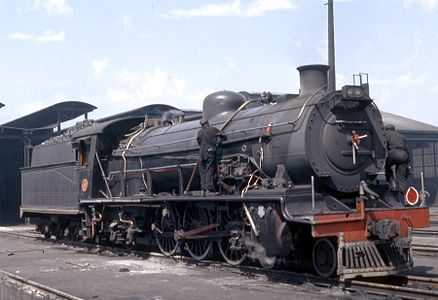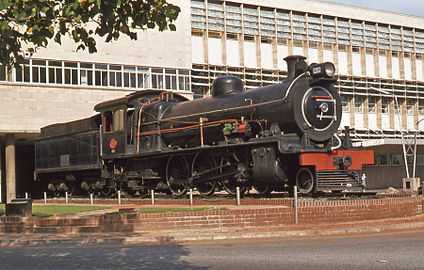South African Class 16B 4-6-2
| South African Class 16B 4-6-2 & South African Class 16CR 4-6-2 | |
|---|---|
|
No. 805 plinthed outside Johannesburg station, 27 March 1978 | |
| Type and origin | |
| Power type | Steam |
| Designer | South African Railways |
| Builder | North British Locomotive Company |
| Serial number | 21492-21501 [1][2] |
| Model | Class 16B |
| Build date | 1917-1918 |
| Total produced | 10 |
| Specifications | |
| Configuration | 4-6-2 "Pacific" |
| Gauge | 3 ft 6 in (1,067 mm) Cape gauge |
| Leading wheel diameter | 30 in (762 mm) |
| Driver diameter | 60 in (1,520 mm) |
| Trailing wheel diameter | 33 in (838 mm) |
| Wheelbase |
Total: 58 ft 11.875 in (17.980 m) Engine: 6 ft 2 in (1.880 m) bogie 10 ft 9 in (3.277 m) coupled 29 ft 5.5 in (8.979 m) total Tender: 6 ft 2 in (1.880 m) bogie 20 ft 5 in (6.223 m) total |
| Length | 66 ft 11.5 in (20.409 m) total |
| Height |
12 ft 10 in (3.912 m) as built 12 ft 11.25 in (3.943 m) reboilered |
| Frame | Plate frame |
| Axle load |
18 long tons (18.3 t) on 1st & 2nd drivers as built 17.7 long tons (18.0 t) on 2nd driver reboilered |
| Weight on drivers |
53.9 long tons (54.8 t) as built 52.8 long tons (53.6 t) reboilered |
| Locomotive weight |
83.65 long tons (85.0 t) as built 81.75 long tons (83.1 t) reboilered |
| Tender weight |
61,520 lb (27.9 t) empty 66 long tons (67.1 t) w/o |
| Locomotive and tender combined weight |
169,008 lb (76.7 t) empty 149.65 long tons (152.1 t) w/o |
| Tender type |
MT - MP, MP1, MR, MS, MT, MT1, MT2, MX, MY, MY1 permitted * 2 axle bogies * 34 in (864 mm) wheels * Length 28 ft 5.375 in (8.671 m) |
| Fuel type | Coal |
| Fuel capacity | 12 long tons (12.2 t) |
| Water capacity | 6,000 imp gal (27,000 l) |
| Boiler |
As built: 5 ft 4.625 in (1.641 m) inside diameter 18 ft 3 in (5.563 m) inside length 7 ft 9 in (2.362 m) pitch Reboilered: 5 ft 7.5 in (1.715 m) inside diameter 18 ft 4 in (5.588 m) inside length, steel firebox 18 ft 3.625 in (5.578 m) inside length, copper firebox 8 ft (2.438 m) pitch |
| Boiler pressure |
180 psi (1,240 kPa) as built 190 psi (1,310 kPa) reboilered |
| Firegrate area | 37 sq ft (3.437 m2) |
| Heating surface: – Tubes |
As built: 131 tubes 2.25 in (57.1 mm) diameter 24 tubes 5.5 in (140 mm) diameter 2,040 sq ft (189.522 m2) Reboilered: 87 tubes 2.5 in (63.5 mm) diameter 30 tubes 5.5 in (140 mm) diameter 1,636 sq ft (151.989 m2) |
| – Firebox |
146 sq ft (13.564 m2) as built 148 sq ft (13.750 m2) reboilered |
| – Total |
2,186 sq ft (203.086 m2) as built 1,978 sq ft (183.762 m2) reboilered |
| Superheater area |
516 sq ft (47.938 m2) as built 472 sq ft (43.850 m2) reboilered |
| Cylinders | Two |
| Cylinder size |
22 in (559 mm) bore 26 in (660 mm) stroke |
| Valve gear | Walschaerts |
| Performance figures | |
| Tractive effort | 29,890 lbf (133 kN) at 75% pressure |
| Career | |
| Operator(s) | South African Railways [3] |
| Class | Class 16B, Class 16CR |
| Number in class | 10 |
| Number(s) | 802-811 |
| Delivered | 1917-1918 |
| First run | 1917 |
| Withdrawn | 1976 |
The South African Class 16B 4-6-2 of 1917 is a South African steam locomotive from the South African Railways era.
In November 1917 the South African Railways placed ten Class 16B steam locomotives with a 4-6-2 Pacific type wheel arrangement in passenger train service.[1]
Manufacturer
The Class 16B 4-6-2 Pacific type locomotive was designed by D.A. Hendrie, Chief Mechanical Engineer (CME) of the South African Railways (SAR) from 1910 to 1922, and built in 1917 by the North British Locomotive Company (NBL) in Glasgow, Scotland. Ten locomotives were delivered and placed in service in November 1917, numbered in the range from 802 to 811. They were identical to the predecessor Class 16 and successor Class 16C in most respects, except that they had wider cabs than the Class 16 while the Class 16C was equipped with a combustion chamber in the firebox.[4]
Watson Standard boilers
During the 1930s many serving locomotives were reboilered with a standard boiler type designed by A.G. Watson, CME of the SAR from 1929 to 1936, as part of his standardisation policy. Such Watson Standard reboilered locomotives were reclassified by adding an "R" suffix to their classification.[3][4]
Eventually all ten Class 16B locomotives as well as all thirty Class 16C locomotives were reboilered with Watson Standard no 2B boilers. In the process of reboilering the main difference between the Class 16B and Class 16C, Hendrie’s combustion chamber behind the Class 16C boiler, disappeared and the reboilered Class 16B locomotives were also reclassified to Class 16CR. Early conversions were equipped with copper and later conversions with steel fireboxes. In the process they were also equipped with Watson cabs, with their distinctive slanted fronts compared to the conventional vertical fronts of their original cabs.[4]
Some ex Class 16B locomotives did, however, erroneously receive new number plates after reboilering identifying them as Class 16BR, even though such an SAR Class never officially existed.[5]
An obvious visual difference between an original and a Watson Standard reboilered locomotive is usually a rectangular regulator cover just to the rear of the chimney on the reboilered locomotive. In the case of the Class 16B and Class 16CR two even more obvious visual differences are the Watson cab and the absence of the Belpaire firebox hump between the cab and boiler on the reboilered locomotives.[3]
Service
The Class 16B Pacifics were placed in express passenger service working out of Pretoria and Johannesburg, hauling all the important passenger trains of the time, such as the Natal mail train on the section between Johannesburg and Volksrust and the Cape mail train on the section between Johannesburg and Klerksdorp. When they were replaced by newer locomotives like the Class 16D, they were relegated to less glamorous passenger duties until, by the 1940s, they were in suburban and transfer service.[1][4]
During the 1950s some were relocated to Durban to assist the Class 14R on the South Coast line. When this line was electrified in 1967, they were again relocated, this time to Port Elizabeth where they worked suburban trains to Uitenhage. Others remained on the Witwatersrand, working the suburban to Springs and Nigel, double-heading with Class 15ARs on Pietersburg-bound trains out of Pretoria, as well as shunting and local pickup service. They were withdrawn from service between 1975 and 1976.[4]
Ben Schoeman
_Ben_Schoeman.jpg)
Of the Class 16B locomotives, number 805 has some claim to fame, since long time South African Minister of Transport Ben Schoeman started his Railway career at Braamfontein during the 1930s as a fireman on this locomotive.[1]
When number 805 was withdrawn from service, by then reboilered and reclassified to Class 16CR, this locomotive was actually de-reboilered to its original Class 16B condition. A dummy boiler that looked like the original boiler with its Belpaire firebox was fabricated and installed and it was refitted with an original wide Hendrie cab that was found dumped at the old Pretoria Mechanical Workshops.[5]
It was then plinthed outside Johannesburg station on 18 and 19 March 1974, with the work taking two days to complete. The Minister of Transport, the Hon. B.J. Schoeman, unveiled the commemorative plaque during a ceremony on 1 July 1974.[5][6]
In the early 1990s the locomotive was removed from Johannesburg station to be exhibited in the Outeniqua Transport Museum at George.[5]
Versions illustrated
The main picture shows no. 805 cosmetically rebuilt to its original Class 16B form with a Belpaire firebox and original cab, while the following shows reboilered Class 16CR locomotives.
-

Class 16 CR no. 810 at Sydenham, November 1971
-
Class 16CR no. 809 at Queenstown, 26 April 2013
See also
- List of South African locomotive classes
- South African Class 16 4-6-2
- South African Class 16A 4-6-2
- South African Class 16C 4-6-2
- South African Class 16D 4-6-2
- South African Class 16DA 4-6-2
- South African Class 16E 4-6-2
- South African locomotive history
- Tender locomotive numbering and classification
- The 4-6-2 "Pacific"
- Watson Standard boilers
References
|
- ↑ 1.0 1.1 1.2 1.3 Holland, D.F. (1972). Steam Locomotives of the South African Railways, Volume 2: 1910-1955 (1st ed.). Newton Abbott, Devon: David & Charles. p. 34. ISBN 978-0-7153-5427-8.
- ↑ North British Locomotive Company works list, compiled by Austrian locomotive historian Bernhard Schmeiser
- ↑ 3.0 3.1 3.2 South African Railways and Harbours Locomotive Diagram Book, 2’0” & 3’6” Gauge Steam Locomotives, 15 August 1941, as amended
- ↑ 4.0 4.1 4.2 4.3 4.4 Paxton, Leith; Bourne, David (1985). Locomotives of the South African Railways (1st ed.). Cape Town: Struik. pp. 10–11, 65. ISBN 0869772112.
- ↑ 5.0 5.1 5.2 5.3 Durrant, A E (1989). Twilight of South African Steam (1st ed.). Newton Abbott, London: David & Charles. p. 92. ISBN 0715386387.
- ↑ SAR-L YahooGroup Message 35393 (Talk:South African Class 16B 4-6-2#Class 16B 805)

